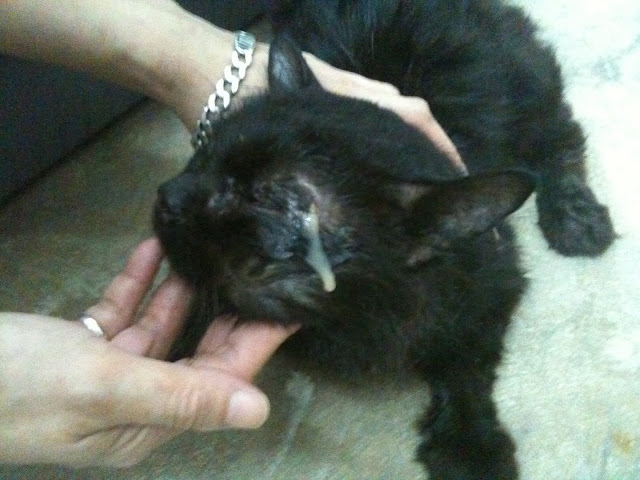
http://cyberita.asia1.com.sg/mrencana/story/0,6879,191525,00.html
26 Jun 2011
EKSTRA!
Usah kejam pada kucing
Hingga 5,100 kucing terbiar dihapuskan syarikat pengawal haiwan perosak tahun lalu
PADA Ramadan lalu, presiden Persatuan Kebajikan Kucing (CWS), Cik Fareena Mehr Omar, menerima laporan mengenai sebuah keluarga Melayu/Islam yang melepaskan dua ekor kucing peliharaan mereka di Changi Village.
Apabila beliau membuat lawatan ke rumah mereka di kawasan Ubi, keluarga itu langsung tidak rasa bersalah dan mengatakan kucing-kucing mereka pasti selamat kerana 'di situ ada banyak makanan'.
Kira-kira sebulan kemudian, dua kucing itu tidak lagi ditemui setelah pihak berkuasa mengerahkan syarikat pengawal haiwan perosak menghapuskan kucing-kucing yang terbiar di situ.
Dalam satu lagi kes pula, sebuah keluarga Melayu di Tampines melepaskan tujuh ekor kucing dewasa yang dimasukkan ke dalam sebuah sangkar dan ditinggalkan di kolong blok, bersama beberapa barang perhiasan rumah yang dibuang.
Cik Fareena berkata kes-kes pemilik kucing melepaskan haiwan peliharaan mereka biasa ditangani persatuannya sepanjang tahun.
Namun, semasa Ramadan, apabila ramai keluarga Melayu/Islam mula mengemas rumah untuk menyambut Syawal, kejadian sedemikian meningkat lebih dua kali ganda.
Walaupun tiada data-data rasmi, Cik Fareena berkata sebahagian besarnya dilakukan pemilik Melayu/Islam, berdasarkan pemerhatian lebih 500 relawannya di serata pulau, yang menjadi 'mata dan telinga' persatuan itu dalam mengesan kes-kes sedemikian.
Para pencinta kucing juga sering memberi maklum balas kepada CWS, kadangkala lengkap dengan gambar dan rakaman video, mengenai perbuatan jiran mereka melepaskan kucing.
Menurut Cik Fareena, para relawannya dibahagikan kepada kelompok di kejiranan mereka, dengan setiap kelompok merangkumi lima hingga 15 blok flat.
Di kelompok masing-masing, para relawan itu memberi makan kepada kucing-kucing terbiar setiap hari.
Lantas, mereka dapat mengesan tiap kali terdapat 'muka-muka baru' yang dilepaskan.
Memberi contoh, pada Ramadan tahun lalu, para relawan CWS mengesan 27 ekor kucing yang dilepaskan di satu kelompok di Jurong West.
Di sebuah kelompok di Eunos pula, 45 ekor kucing dilepaskan manakala jumlah di Bedok dan Tampines mencecah 25 dan 17 ekor kucing.
Pada bulan-bulan biasa, secara purata, tiga hingga 10 ekor kucing dilepaskan di kejiranan-kejiranan tersebut.
Trend ini konsisten sejak beberapa tahun lalu.
LEPASKAN KUCING SAMA SEPERTI MEMBUNUHNYA
Menurut Cik Fareena, ada salah tanggapan bahawa kucing yang dilepaskan tetap dapat hidup di luar.
'Realitinya, apabila anda melepaskan kucing samalah seperti anda membunuhnya,' tegas beliau.
Ini kerana kucing yang terbiasa dengan kehidupan di rumah sukar menyesuaikan diri apabila dilepaskan. Ia terdedah kepada penganiayaan dan mudah ditangkap oleh pegawai penghapus haiwan perosak.
Malah, banyak juga yang 'membunuh diri' dengan bersembunyi di dalam longkang-longkang dan enggan bergerak kerana terlalu takut.
'Ada satu kes kucing yang dilepaskan di bawah pokok. Ia langsung tidak bergerak kerana terlalu takut, walaupun seluruh tubuhnya diselaputi semut,' keluh Cik Fareena.
Sejumlah 5,100 kucing terbiar dihapuskan syarikat pengawal haiwan perosak tahun lalu. Pada 2009, 5,400 ekor kucing dihapuskan manakala 6,800 ekor pula dihapuskan pada 2008.
Baru-baru ini, dalam tulisan blognya, Menteri Pembangunan Negara, Encik Khaw Boon Wan, mengarah Persatuan Pertanian-Makanan dan Ternakan (AVA) agar menyemak amalan menghapuskan kucing-kucing terbiar.
Menteri Negara (Pembangunan Negara merangkap Tenaga Manusia), Brigadier-Jeneral (Kerahan) Tan Chuan-Jin, juga ditugaskan bekerjasama dengan AVA, pertubuhan kebajikan haiwan dan penduduk bagi mengorak pendekatan lebih ihsan terhadap masalah kucing terbiar.
KEMBIRI KUCING HURAIAN JANGKA PANJANG
Minggu lalu, Majlis Bandaran Sembawang mengumumkan ia tidak akan lagi menghapuskan kucing-kucing terbiar di kejiranan Chong Pang, sebaliknya akan bekerjasama dengan pertubuhan pencinta kucing untuk mengembiri haiwan-haiwan tersebut.
Langkah sedemikian disambut baik oleh CWS.
Menurut relawan CWS, Cik Suzana Sainol, program pendekatan persatuan itu mendedahkan ramai pemilik Melayu/Islam yang enggan mengembiri kucing mereka.
'Ada yang mungkin bermula dengan niat yang baik, memelihara hanya dua atau tiga ekor kucing.
'Tapi apabila kucing-kucing mereka tidak dikembiri dan mula beranak, keadaan menjadi tidak terkawal dan mulalah sesetengah mereka melepaskan kucing-kucing ini,' ujar beliau.
Cik Suzana menerangkan antara sebab yang diberi ialah kos mengembiri, antara $80 dengan $230, bergantung kepada jantina dan klinik yang menawarkan khidmat tersebut.
Beliau menambah, kucing yang tidak dikembiri juga menimbulkan masalah lain, terutama semasa musim mengawan.
Lantas, bagi menggalak keluarga Melayu/Islam mengembiri kucing peliharaan mereka, CWS telah melancarkan program mengembiri pada kadar bersubsidi, antara $25 dengan $60.
Selain isu kos, Cik Fareena berkata ramai orang Melayu juga ragu-ragu mahu mengembiri kucing kerana menganggap ia salah dari sudut agama.
Ini walaupun fatwa Muis yang dikeluarkan pada 1994 memutuskan bahawa mengembiri kucing atas sebab-sebab maslahat adalah harus.
MEMBENARKAN KUCING
DI FLAT HDB
Kini, Lembaga Perumahan dan Pembangunan (HDB) tidak membenarkan pemilik flat memelihara kucing.
Antara lain, tabiat haiwan itu seperti menggugurkan bulunya, mengiau dengan kuat serta buang najis di tempat-tempat awam, mengganggu suasana kejiranan.
Namun, pertubuhan kebajikan haiwan seperti CWS berpendapat perubahan dasar itu mungkin dapat menjadi huraian jangka panjang kepada masalah kucing-kucing terbiar.
Pendekatan yang serupa seperti memelihara anjing boleh digunakan dengan mewajibkan orang ramai memohon lesen untuk memelihara kucing dan memasang cip komputer mikro pada kucing.
Bagaimanapun, Cik Fareena akur ini bukan satu langkah yang mudah.
'Sekarang ini pun, ada kelemahan dalam sistem pemeliharaan anjing dan untuk sistem ini dikuatkuasa bagi kucing, mungkin memakan masa.
'Namun, ulasan Encik Khaw yang mencerminkan pendekatan pemerintah yang terbuka untuk bekerjasama dengan pencinta kucing dan masyarakat secara umum memberi pertubuhan seperti kami harapan,' ujarnya.









































